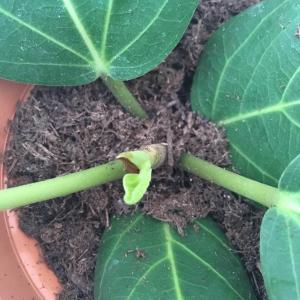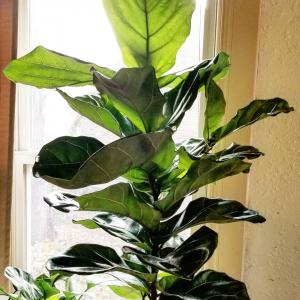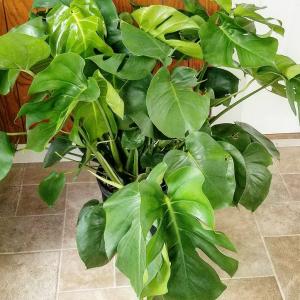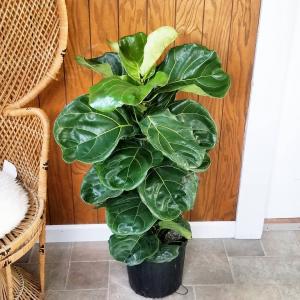文章
Miss Chen
2017年11月20日

Tomato plants (Solanum lycopersicum) are prized for their crimson, juicy fruit. You're not the only one who enjoys the taste of tomatoes. Various pests may attack and feed on the tomato plant's fruit and foliage, causing leaf loss, plant stress and potential fruit loss. Protect your garden from some of the most common pests that afflict tomato plants.

Psyllids
Psyllids are tiny yellow or green insects that congregate on the underside of tomato leaves and inject a poison into the leaves, turning the tomato plant's foliage yellow and purple. These pests rarely reach population levels that cause true damage; most gardeners simply dislike psyllids for aesthetic reasons.
If you choose to control and eradicate psyllids, make your own psyllid insecticide at home:
Step 1
Pour 1/2 ounce of liquid hand soap or liquid dish detergent into a reusable spray bottle.
Step 2
Add 2 quarts of water to the spray bottle.
Step 3
Mix thoroughly.
Step 4
Spray the soapy solution onto affected portions of the tomato plant, focusing on the underside of leaves where psyllids like to gather.

Step 5
Repeat once a week until psyllid activity subsides.
Flea Beetles
Flea beetles, another common tomato pest, are brown or black beetles that hop away from you when touched. The adult beetles eat small holes into the foliage of the tomato plant.
Cover the vegetable bed with a floating row cover to block out beetles and protect young tomato plants. A floating row cover is an ultralight, ultrathin landscaping sheet that keeps pests from reaching the underlying plants but still lets sunlight and water get through. Drape the row cover over the garden bed as soon as tomato seedlings emerge, and weigh down the edges of the sheet with rocks or with U-shaped garden pins.
If flea beetles have already arrived, a floating row cover will not help. Instead, dust all exposed surfaces of the tomato plants with food-grade diatomaceous earth. This all-natural powder is made from crushed diatoms. The powder's tiny, sharp edges kill flea beetles.
Hornworms
If you see large gray-green or green caterpillars crawling on your tomato plants, you have a tomato hornworm problem. This pest is a fast eater. In just a few days, the caterpillars can completely strip the entire tomato plant of its leaves and fruit.
Pick the hornworms off of the tomato plant by hand. This is a convenient, efficient and simple way to eradicate the problem. Crush the caterpillars or drop them into a bucket of soapy water to kill them.
If you prefer a hands-off approach, use an organic caterpillar insecticide made with Bacillus thuringiensis kurstaki. Bt is a natural bacterium that kills caterpillars when it gets ingested. Bt insecticides come in sprays and powders.
Follow all labeled guidelines for product-specific application instructions. For example, when using a Bt insecticide powder with 0.4365 percent Bt, apply at a rate of 2 ounces for every 50 feet of row planting, dusting the powder evenly on all exposed parts of the tomato plant.
Whiteflies and Aphids
Whiteflies and aphids suck on the sap of the tomato plant and can cause wilting and leaf loss. A common symptom for either pest is the presence of honeydew -- a sticky, shiny substance excreted by the insects when they're feeding.
Spray the tomato plant with a strong jet of water from a garden hose. This is often all that's required to knock the aphids and whiteflies off of the plant and kill them. Repeat once a week to keep pest populations low.
Stink Bugs
Last but not least on the tomato plant's most-wanted pest list are stink bugs. These shield-shaped beetles come in various colors, including brown and green. If touched, they let out a pungent odor, hence their name. Stink bugs feed on tomato fruits causing spotting and the inner tissue becomes spongy and white. The first sign of damage appears as tiny dark spots surrounded by discoloring that can turn yellowish or green as the fruit matures.
Handpick the stink bugs off of the tomato plant -- wear gloves if you want to avoid their trademark stench -- and crush the bugs or drop them into a bucket of soapy water. Alternatively, use a handheld vacuum to quickly suck the insects off of the affected plant. Remove the vacuum's dust bag, place it in a sealed plastic bag and toss it in your freezer for a couple days to kill the trapped stink bugs.

Psyllids
Psyllids are tiny yellow or green insects that congregate on the underside of tomato leaves and inject a poison into the leaves, turning the tomato plant's foliage yellow and purple. These pests rarely reach population levels that cause true damage; most gardeners simply dislike psyllids for aesthetic reasons.
If you choose to control and eradicate psyllids, make your own psyllid insecticide at home:
Step 1
Pour 1/2 ounce of liquid hand soap or liquid dish detergent into a reusable spray bottle.
Step 2
Add 2 quarts of water to the spray bottle.
Step 3
Mix thoroughly.
Step 4
Spray the soapy solution onto affected portions of the tomato plant, focusing on the underside of leaves where psyllids like to gather.

Step 5
Repeat once a week until psyllid activity subsides.
Flea Beetles
Flea beetles, another common tomato pest, are brown or black beetles that hop away from you when touched. The adult beetles eat small holes into the foliage of the tomato plant.
Cover the vegetable bed with a floating row cover to block out beetles and protect young tomato plants. A floating row cover is an ultralight, ultrathin landscaping sheet that keeps pests from reaching the underlying plants but still lets sunlight and water get through. Drape the row cover over the garden bed as soon as tomato seedlings emerge, and weigh down the edges of the sheet with rocks or with U-shaped garden pins.
If flea beetles have already arrived, a floating row cover will not help. Instead, dust all exposed surfaces of the tomato plants with food-grade diatomaceous earth. This all-natural powder is made from crushed diatoms. The powder's tiny, sharp edges kill flea beetles.
Hornworms
If you see large gray-green or green caterpillars crawling on your tomato plants, you have a tomato hornworm problem. This pest is a fast eater. In just a few days, the caterpillars can completely strip the entire tomato plant of its leaves and fruit.
Pick the hornworms off of the tomato plant by hand. This is a convenient, efficient and simple way to eradicate the problem. Crush the caterpillars or drop them into a bucket of soapy water to kill them.
If you prefer a hands-off approach, use an organic caterpillar insecticide made with Bacillus thuringiensis kurstaki. Bt is a natural bacterium that kills caterpillars when it gets ingested. Bt insecticides come in sprays and powders.
Follow all labeled guidelines for product-specific application instructions. For example, when using a Bt insecticide powder with 0.4365 percent Bt, apply at a rate of 2 ounces for every 50 feet of row planting, dusting the powder evenly on all exposed parts of the tomato plant.
Whiteflies and Aphids
Whiteflies and aphids suck on the sap of the tomato plant and can cause wilting and leaf loss. A common symptom for either pest is the presence of honeydew -- a sticky, shiny substance excreted by the insects when they're feeding.
Spray the tomato plant with a strong jet of water from a garden hose. This is often all that's required to knock the aphids and whiteflies off of the plant and kill them. Repeat once a week to keep pest populations low.
Stink Bugs
Last but not least on the tomato plant's most-wanted pest list are stink bugs. These shield-shaped beetles come in various colors, including brown and green. If touched, they let out a pungent odor, hence their name. Stink bugs feed on tomato fruits causing spotting and the inner tissue becomes spongy and white. The first sign of damage appears as tiny dark spots surrounded by discoloring that can turn yellowish or green as the fruit matures.
Handpick the stink bugs off of the tomato plant -- wear gloves if you want to avoid their trademark stench -- and crush the bugs or drop them into a bucket of soapy water. Alternatively, use a handheld vacuum to quickly suck the insects off of the affected plant. Remove the vacuum's dust bag, place it in a sealed plastic bag and toss it in your freezer for a couple days to kill the trapped stink bugs.
1
0
文章
Miss Chen
2017年11月20日

Don't be alarmed if you discover curled-up leaves on your otherwise healthy-looking tomato plants. Leaf curl, also called leaf roll, usually does not affect the quantity or quality of the tomatoes, according to the University of Illinois Extension service. Causes of leaf curl can include a physiological condition, exposure to herbicides or a virus affecting the tomato plant. Gardeners can take steps to prevent leaf curl, but the measures depend the source of the problem.
Physiological Leaf Curl

Rainy weather combined with cool temperatures can cause tomato plant leaves to curl or roll up on themselves. The condition, known as physiological leaf curl, can also affect seedlings soon after you transplant them outdoors. The problem does not require treatment because it does not inhibit plant growth or harm the fruit, says Judy Sedbrook, Colorado master gardener with the Colorado State University Cooperative Extension. Another type of physiological leaf roll--termed "non-parasitic leaf roll"--occurs in response to over-pruning or lack of water. The leaf curl will usually disappear in a few days, once the plant recovers from pruning or its water supply stabilizes.
Herbicide-Caused Leaf Curl

Tomato plants exposed to herbicides can show signs of leaf curl, and in severe cases, the leaf surface becomes white and the leaf itself turns thick and brittle. The most common herbicidal cause of leaf curl comes from 2,4-D, which is often used to treat lawns or crops for weeds. To minimize tomato plants' exposure to herbicides, never spray your plants with same sprayer that you use on your lawn. Don't use treated grass clippings as mulch around tomato plants. Herbicidal leaf curl can result in a harder-than-normal or misshapen tomato fruit, but unless the exposure to the herbicide is prolonged and severe, most plants will recover, especially if you provide them with frequent watering.
Leaf Curl Virus

Sucking insects like the sweet potato whitefly and aphid transmit a disease known as the tomato yellow leaf curl virus. The condition usually affects tomatoes that grow indoors. Leaves that curl upward occur in the first stages of infection, then the leaves curl downward and become yellow. Since no cures exist for the virus, the best way to prevent yellow leaf curl virus is to control insect infestations and select healthy, insect-free transplants for fruit production.
Physiological Leaf Curl

Rainy weather combined with cool temperatures can cause tomato plant leaves to curl or roll up on themselves. The condition, known as physiological leaf curl, can also affect seedlings soon after you transplant them outdoors. The problem does not require treatment because it does not inhibit plant growth or harm the fruit, says Judy Sedbrook, Colorado master gardener with the Colorado State University Cooperative Extension. Another type of physiological leaf roll--termed "non-parasitic leaf roll"--occurs in response to over-pruning or lack of water. The leaf curl will usually disappear in a few days, once the plant recovers from pruning or its water supply stabilizes.
Herbicide-Caused Leaf Curl

Tomato plants exposed to herbicides can show signs of leaf curl, and in severe cases, the leaf surface becomes white and the leaf itself turns thick and brittle. The most common herbicidal cause of leaf curl comes from 2,4-D, which is often used to treat lawns or crops for weeds. To minimize tomato plants' exposure to herbicides, never spray your plants with same sprayer that you use on your lawn. Don't use treated grass clippings as mulch around tomato plants. Herbicidal leaf curl can result in a harder-than-normal or misshapen tomato fruit, but unless the exposure to the herbicide is prolonged and severe, most plants will recover, especially if you provide them with frequent watering.
Leaf Curl Virus

Sucking insects like the sweet potato whitefly and aphid transmit a disease known as the tomato yellow leaf curl virus. The condition usually affects tomatoes that grow indoors. Leaves that curl upward occur in the first stages of infection, then the leaves curl downward and become yellow. Since no cures exist for the virus, the best way to prevent yellow leaf curl virus is to control insect infestations and select healthy, insect-free transplants for fruit production.
0
0
成长记
cclecombe
2017年11月18日

We sadly lost some leaves today but we’ve got a new leaf opening up and a new shoot happening!






0
0
成长记
Llamadrama
2017年11月12日
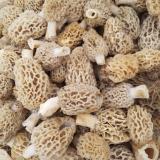
I now added "Adromischus cristatus - Crinkle Leaf Plant" in my "garden"
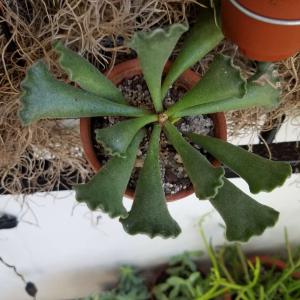

0
0
求助
XVII-Blackheart
2017年11月12日

It's definitely not a Black night. And it's just a dark green colour, with lighter green in the middle. It also has different leaf tips than it. I'm sure it's an Echeveria Elegans. But I'd really love to know it's official name. Thanks!

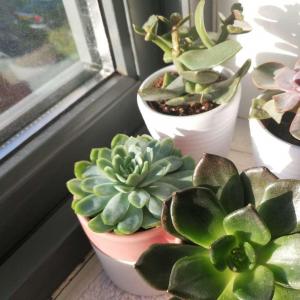


0
0
shirly mei:I am pretty sure this is not a Echeveria elegans but a Echeveria black prince. the more light it has, the more it will become darker.
Ueca
2017年11月10日

Some leaf propagation.
Species: Pachyphytum compactum, Pachyveria clavifolia, Anacampseros rufescens, and Sinocrassula indica.
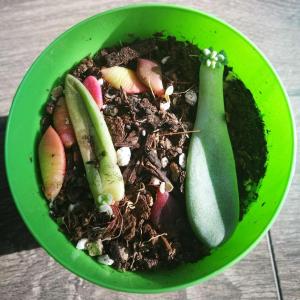
Species: Pachyphytum compactum, Pachyveria clavifolia, Anacampseros rufescens, and Sinocrassula indica.

1
0
成长记
Deanna Dubbs
2017年10月24日

I came home from work to find this little guy! This is a leaf from the original Gannon! My first (successful) propigation! can’t wait to see the progress :)
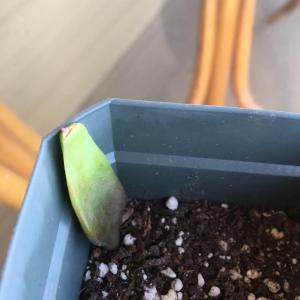

1
0
成长记
Ueca
2017年10月20日

It got more plump. Can anybody tell if the bottom leaf is rotting or if it's sunburn?
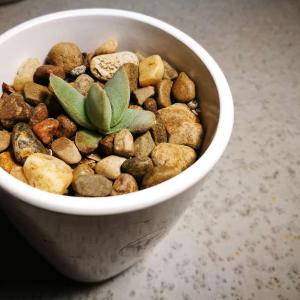

2
0
meriunkat:hmm it looks like the tip is drying up


